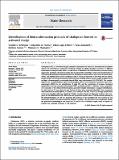Por favor, use este identificador para citar o enlazar a este item:
http://hdl.handle.net/10261/345511COMPARTIR / EXPORTAR:
 SHARE SHARE
 CORE
BASE CORE
BASE
|
|
| Visualizar otros formatos: MARC | Dublin Core | RDF | ORE | MODS | METS | DIDL | DATACITE | |

| Título: | Identification of biotransformation products of citalopram formed in activated sludge |
Autor: | Beretsou, Vasiliki G.; Psoma, Aikaterini K.; Gago-Ferrero, Pablo CSIC ORCID; Aalizadeh, Reza; Fenner, Kathrin; Thomaidis, Nikolaos S. | Palabras clave: | Transformation products Citalopram HILIC LC-QTOF-MS Metabolites Retrospective analysis |
Fecha de publicación: | 15-oct-2016 | Editor: | Elsevier | Citación: | Water Research 103: 205-214 (2016) | Resumen: | Citalopram (CTR) is a worldwide highly consumed antidepressant which has demonstrated incomplete removal by conventional wastewater treatment. Despite its global ubiquitous presence in different environmental compartments, little is known about its behaviour and transformation processes during wastewater treatment. The present study aims to expand the knowledge on fate and transformation of CTR during the biological treatment process. For this purpose, batch reactors were set up to assess biotic, abiotic and sorption losses of this compound. One of the main objectives of the study was the identification of the formed transformation products (TPs) by applying suspect and non-target strategies based on liquid chromatography quadrupole-time-of-flight mass spectrometry (LC-QTOF-MS). The complementary use of reversed phase liquid chromatography (RPLC) and hydrophilic interaction liquid chromatography (HILIC) for the identification of polar TPs, and the application of in-house developed quantitative structure-retention relationship (QSRR) prediction models, in addition to the comprehensive evaluation of the obtained MS/MS spectra, provided valuable information to support identification. In total, fourteen TPs were detected and thirteen of them were tentatively identified. Four compounds were confirmed (N-desmethylCTR, CTR amide, CTR carboxylic acid and 3-oxo-CTR) through the purchase of the corresponding reference standard. Probable structures based on diagnostic evidence were proposed for the additional nine TPs. Eleven TPs are reported for the first time. A transformation pathway for the biotransformation of CTR was proposed. The presence of the identified TPs was assessed in real wastewater samples through retrospective analysis, resulting in the detection of five compounds. Finally, the potential ecotoxicological risk posed by CTR and its TPs to different trophic levels of aquatic organisms was evaluated by means of risk quotients. | Versión del editor: | https://doi.org/10.1016/j.watres.2016.07.029 | URI: | http://hdl.handle.net/10261/345511 | DOI: | 10.1016/j.watres.2016.07.029 | ISSN: | 00431354 |
| Aparece en las colecciones: | (IDAEA) Artículos |
Ficheros en este ítem:
| Fichero | Descripción | Tamaño | Formato | |
|---|---|---|---|---|
| 2016 TPs Citalopram (Water Research).pdf | Artículo principal | 1,86 MB | Adobe PDF |  Visualizar/Abrir |
| 1-s2.0-S0043135416305334-mmc1.docx | Material suplementario | 2,89 MB | Microsoft Word XML | Visualizar/Abrir |
CORE Recommender
PubMed Central
Citations
7
checked on 09-abr-2024
SCOPUSTM
Citations
56
checked on 25-abr-2024
WEB OF SCIENCETM
Citations
49
checked on 29-feb-2024
Page view(s)
8
checked on 29-abr-2024
Download(s)
4
checked on 29-abr-2024
Google ScholarTM
Check
Altmetric
Altmetric
Artículos relacionados:
NOTA: Los ítems de Digital.CSIC están protegidos por copyright, con todos los derechos reservados, a menos que se indique lo contrario.


